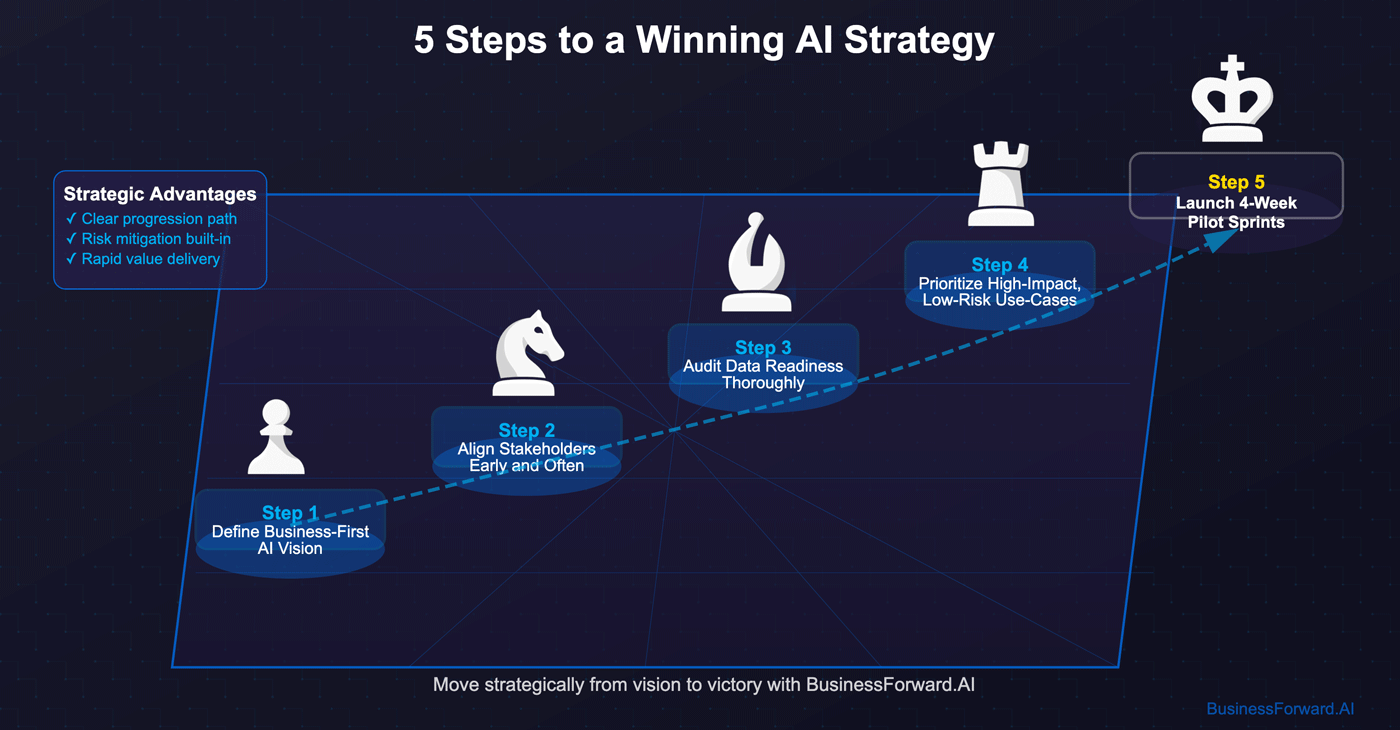Introduction — Moving From Curiosity to Competitive Edge
Artificial intelligence is embedded in quarterly earnings calls and shareholder letters—not just slide decks. McKinsey's 2024 State of AI report shows that 55 % of enterprises have at least one AI use–case in production, yet fewer than one–in–five have scaled beyond pilots. The performance gap is no longer about algorithms or GPUs; it is about having a well–governed, business–first AI Strategy that delivers measurable value quickly and sustainably. The five–step blueprint below has guided Fortune 500 and mid–market firms alike from experimentation to enterprise–wide capability.

Step 1 — Define a Business–First AI Vision
Link AI Ambitions to Corporate Objectives
AI initiatives thrive when they tie directly to revenue, cost, and risk metrics already tracked in the C–suite.
| Objective Category | Illustrative AI Opportunity | KPI Example |
|---|---|---|
| Revenue Growth | Dynamic pricing engine | +3 % gross margin |
| Cost Efficiency | Predictive maintenance | –25 % unplanned downtime |
| Risk Mitigation | Real–time fraud detection | –40 % charge–backs |
Action Checklist
- Draft a one–page AI North Star statement.
- Select three to five use–cases with quantified KPIs.
- Publish a 12–month AI roadmap for executives.
Step 2 — Align AI Project Stakeholders Early and Often
Build an AI Strategy Coalition
A successful AI Strategy framework needs champions across four groups:
| Stakeholder | Focus Questions | What They Need |
|---|---|---|
| Executive Sponsors | ROI, competitive advantage | Payback timeline, risk controls |
| IT & Security | Integration, uptime, compliance | Architecture diagrams, governance |
| Business Units | Workflow impact, metrics | Clear "before vs after" scenarios |
| Data Stewards | Quality, privacy, lineage | Data–readiness scorecard |
Case note: A global logistics client saved $1.2 million and six months by eliminating redundant pilots uncovered during its alignment workshop.
Action Checklist
- Invite one empowered representative per group.
- Create a shared RACI matrix for decisions.
- Schedule monthly governance board meetings.
Step 3 — Audit Data Readiness For AI Implementation
Measure Data Quality, Accessibility, and Compliance
Gartner estimates poor data quality costs organizations $12.9 million annually. A comprehensive audit ensures ambitious AI projects aren't derailed mid–implementation.
Audit Dimensions
- Quality — Accuracy, completeness, timeliness
- Accessibility — API or event–stream availability
- Governance — GDPR/CCPA, SOC 2 alignment
- Infrastructure — Scalable storage & compute
A healthcare provider uncovered seven siloed EHR systems; integration became Phase 0, preventing a costly reset later.
Action Checklist
- Catalog all structured and unstructured data sources.
- Score each on a 1–5 readiness scale; target ≥ 3 before pilots.
- Draft a data–governance charter to satisfy auditors.
Step 4 — Prioritize High–Impact, Low–Risk Use–Cases
Use a 3 × 3 Feasibility Matrix
Retail case: Inventory optimization for 200 SKUs cut excess stock by 15 % and boosted availability by 8 % in just four months.
Quick–Win Criteria
- High–quality, accessible data
- Clear KPI & stakeholder owner
- Deliverable within one quarter
- Budget under $50 K
Step 5 — Launch 4–Week AI Pilot Sprints
The 4–4–4 AI Pilot Model
| Week | Activities | Deliverables |
|---|---|---|
| 1 — Design | KPI, security review | Sprint backlog & architecture |
| 2 — Build | LoRA tuning, RAG setup | Alpha model & vector store |
| 3 — Integrate/Test | APIs, red–team prompts | UAT sign–off |
| 4 — Deploy/Train | Rollout, micro–courses | Live MVP & docs |
Within $50 K and 30 days you have a functioning, measurable AI asset—proof for finance, inspiration for business units.
Scale with Governance, MLOps, and Upskilling
Establish an AI Center of Excellence covering technical standards, business intake, training, and governance. Harvard Business Review reports companies that invest in AI Upskilling achieve adoption 3× faster than peers.
ROI Snapshot & Budget Guidelines
| Spend Category | % of Budget | Notes |
|---|---|---|
| Strategy & Advisory | 10–15 % | External consultants & playbooks |
| Data Engineering | 25–30 % | Integration, cleansing, pipelines |
| Tech & Development | 30–40 % | Models, cloud/GPU, DevOps |
| Change Management | 15–20 % | Training, comms, incentives |
| Ongoing MLOps | 10–15 % | Monitoring, retraining, support |
Avoid These Common Pitfalls
- Tech–first experiments → Anchor backlog items to KPIs.
- Shadow IT models → Centralize feature store & security reviews.
- One–and–done pilots → Fund a rolling pipeline tied to roadmap.
- Training as afterthought → Budget 15 % for Upskilling from day one.
Future AI Trends to Watch
- Domain–specific small models will outpace giant LLMs on cost–to–value.
- Edge AI will require sub–50 ms inference for real–time decisions.
- Regulatory pressure (EU AI Act) will elevate auditability.

